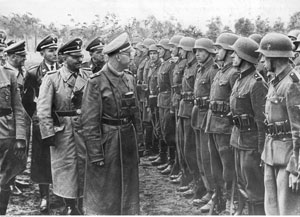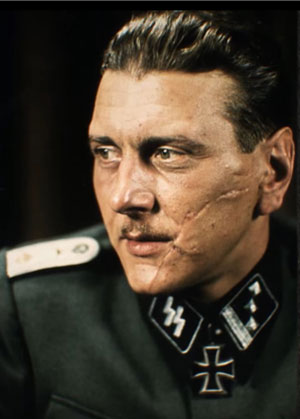By John Mulqueen

In May 1945 many in German uniforms who fought to the end in Berlin were not German: Estonian, French, Latvian and Scandinavian Waffen-SS soldiers tried in vain to halt the Red Army juggernaut. The smallest section in the military wing of the SS, the British Free Corps, also played a role. There were two Irishmen who fought in the Battle of Berlin: James Brady and Frank Stringer.
As Germany officially mourned the military catastrophe of Stalingrad in February 1943, Francis Stuart alluded to Nazi propaganda about the ‘heroes’ of the Sixth Army: the Irish collaborator told his radio listeners at home that this was Germany’s Easter Rising moment. ‘If I was a German,’ Stuart declared, ‘I should be filled with the deepest pride. I am glad to be living in a country that can produce such men.’ Later that year two Irish POWs, who had not made the grade as saboteurs, enlisted in the German armed forces. Brady, a Roscommon man, and Stringer, from County Leitrim—soldiers in the British Army’s Royal Irish Fusiliers—were among a group of eleven Irish POWs who had agreed to work for German military intelligence, the Abwehr.
WAFFEN-SS
Brady and Stringer volunteered to serve in the Waffen-SS, which at its height had nearly a million men in its ranks, half of whom were recruited outside Germany. Its foreign soldiers included 2,000 Indian POWs who joined the ‘Free Indian Legion’. By contrast, the British Free Corps numbered twenty at its peak. An MI5 report on the latter group noted that recruiting British army POWs to fight in the German interest was ‘an old idea, being analogous to the Irish Brigade formed by [Sir Roger] Casement during the last war’. While the Germans made a serious effort during the Second World War to persuade, or coerce, Irish POWs into switching sides, they were even less successful in this than Casement.

Films about POW camps in Hitler’s Germany have created a false impression of the prisoners’ time in them. In The Great Escape, for example, conditions are tolerable, and life for the officers is not much more uncomfortable than in an English public school. Private soldiers and NCOs, however, had a different experience. Most prisoners received just about enough food to stay alive, and found themselves in insanitary, overcrowded accommodation that was bitterly cold in winter and uncomfortably hot in summer. Following the evacuation at Dunkirk in 1940 the Germans began to segregate POWs belonging to ‘national minorities’: Ukrainians and Poles were separated, Flemings and Belgians, Bretons and French, and Irish and British. Those Irish POWs thought to be potential recruits for the Germans were transferred to a special camp at Friesack.
Gerald Johnson, captured five days after landing at Calais, marched to Germany for three weeks in a column of prisoners who were then transported in cattle wagons to Poland. Johnson said that he agreed to go to the Irish camp because of the bad conditions in Poland, but he found Friesack worse: ‘The food was really terrible. We were taken out to work in the dark in the mornings and didn’t return [until] late evening […] The German guards were brutal and used to knock us about. They tried to make us stand to attention to the Nazi flag.’
ANTI-BRITISH PROPAGANDA
The Irish prisoners were bombarded with anti-British propaganda, which highlighted the dangers to the Irish state of Britain taking back the ‘treaty ports’ during the U-boat war. A German actor, who spoke good English and had visited Ireland before the war, conducted most of the assessments for transfer to the Irish POW camp. Stuart, one of two interviewers initially, soon tired of the role. He expected a more enthusiastic response and was disappointed with the calibre of those few who did volunteer. Just eleven in total, deemed to be the most anti-British, decided to work with the Germans. In volunteering for training as saboteurs, these POWs were told that they could defend their homeland if, or when, Churchill decided to invade. By the spring of 1941 the Irish camp held between 150 and 200 men, and the propaganda took its toll on them in that it created confusion and division.

Johnson described how German officers interviewed POWs in the summer of 1941. ‘They interviewed practically everybody in the camp […] always on our own.’ If the ‘treaty ports’ were taken by force, would Johnson fight for Ireland? Johnson said that anti-British views were now articulated. ‘We had no news at all of what was going on […] A lot of us did think that England was going [to go] to war with Éire to get the ports.’ In late 1942 the Germans arrested their commanding officer, Major John McGrath, and placed him in solitary confinement in Sachsenhausen. McGrath, a former music-hall manager in Dublin, had given details about the trainee saboteurs to a priest, which he was to pass on to the Irish authorities.
STRINGER AND BRADY
The unlikely involvement of Stringer and Brady in the Waffen-SS began in Guernsey, when before the war started, and still teenagers, they went on a spree that ended violently. They were convicted of assault and imprisoned. After the war, Brady outlined how they became prisoners of the Germans:
‘Together with another soldier […] Stringer, I got drunk in June 1939, and we assaulted a civilian policeman, although I cannot remember much about it because I was too drunk […]. Towards the end of 1939 we asked to be returned to our unit as the war had started […]. We again asked to be returned to Britain when we knew the Germans would invade the island […]. About the third week in September 1940, my sentence expired, and together with Stringer, who was then released from prison, I was […] placed in a German transport and taken to St Lo, near Cherbourg, in France.’
In the spring of 1941 Brady and Stringer were taken to Friesack. Stringer volunteered to work with the Germans, he said, because ‘I thought that once I got to England or Ireland, I would report the matter’. He learned how to make explosives for a mission in England, but this operation did not go ahead. After months of toing and froing, including three weeks in prison for breaching radio security, Stringer ended up on a farm in Pomerania. He found the work hard, ‘but it was better than prison’, his other option.
In April 1943 the two Irishmen were sent to Berlin for radio training, and in the summer their trainer took them to Russia to make daily contact with a station in Berlin. This did not work out. They were told that they would never attain the required standard and were then offered a choice: work as labourers or join the army. ‘We both volunteered for the army,’ Stringer said. ‘Neither of us asked to go back to [Friesack]. I don’t know why, I just didn’t ask […] we knew too much.’
He and Brady travelled to the training centre for Waffen-SS recruits in Alsace, where there were some French, Norwegians, Danes, Flemings and Dutch. The two recruits were tattooed with their blood groups under the left arm. Eight months later, in May 1944, they joined a battalion commanded by the flamboyant Otto Skorzeny. Their commander had found fame the previous year when he rescued Mussolini, the deposed Italian dictator, from captivity. When Stringer returned from yet more radio training, he found that most of his unit had left to prepare for an undercover role disguised as an American tank unit.
Early in 1945 the battalion headed east to face the Red Army at the Oder, where Brady was wounded. Despite being almost wiped out, everybody in the unit who could fight then withdrew to Berlin—where Brady was wounded again and hospitalised. The two Irish Waffen-SS soldiers survived the war. Stringer passed himself off as a POW to the Americans in Austria and arrived in Brussels in June 1945. Brady, too, succeeded in getting into American-held territory and, after various adventures, arrived in London in September 1946.
AFTER THE WAR …

Stringer’s claims not to have been an enthusiastic collaborator did not persuade his interrogators—his blood group tattoo proved that he had joined the SS. As a British soldier, the question of his Irish—or ‘Éireann’—nationality did not arise, and a court martial sentenced him to fourteen years for voluntarily serving with the enemy. Brady—whose defence counsel told his court martial that he had been ‘practically abandoned to the enemy’—received a fifteen-year sentence for the same offence. The two Irishmen were both released from prison four years later and chose to avoid more drama: Stringer in England and Brady in Ireland.
Otto Skorzeny had a charmed life once the Cold War began. He was acquitted of war crimes in 1947. The Soviets and Czechs demanded his extradition as a war criminal, but Skorzeny, seen as a valuable intelligence asset by the Americans, escaped and succeeded in helping former Nazis to evade justice. The former commando himself found refuge in Franco’s Spain. Amid rumours of his continuing involvement with post-war Nazi networks in Europe and elsewhere, in the late 1950s Skorzeny appeared in Ireland, where he bought a house and sought a right to permanent residency. In 1963 Noël Browne asked questions in the Dáil about Skorzeny, but Ireland held little interest for him by this stage.
The Anglophobic Francis Stuart was the only serious Irish Nazi collaborator. Although a skilled broadcaster, he came nowhere close to William Joyce, ‘Lord Haw-Haw’, in radio appeal. (One of Joyce’s Irish fans later claimed to have heard him say that there was a ‘rumour’ that the victorious Japanese marched through Singapore in 1942 with a band playing ‘The Boys of Kilmichael’; Lt. Gen. Arthur Percival, who surrendered the city, had served in Cork during the War of Independence and had been outfoxed by Tom Barry at the battle of Crossbarry.) Stuart, who supported Hitler’s war to the bitter end, fared relatively well after the war. Detained by the French without trial for eight months, he wrote several novels before returning to Ireland in 1959.
Stuart was right about the brutalised Irish POWs that he interviewed at Friesack: they had no interest in serving the interests of the Third Reich—unlike him. Only two, faced with the prospect of prison, took up arms for Hitler. There were no Irishmen who could match the standard of Stuart’s ‘heroes’ of the Sixth Army—no bad thing.
John Mulqueen is preparing a study of Frank Ryan and the Irish men and women who fought fascism in Europe.
Further reading
B. Barrington (ed.), The wartime broadcasts of Francis Stuart: 1942–1944 (Dublin, 2000).
D. Leach, Fugitive Ireland: European minority nationalists and Irish political asylum, 1937–2008 (Dublin, 2009).
A. Weale, Renegades: Hitler’s Englishmen (London, 2002).
